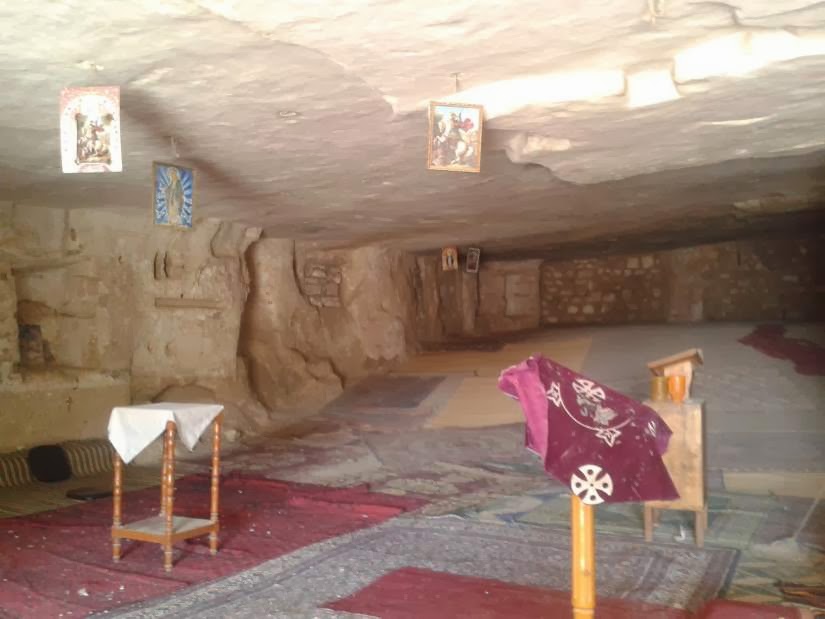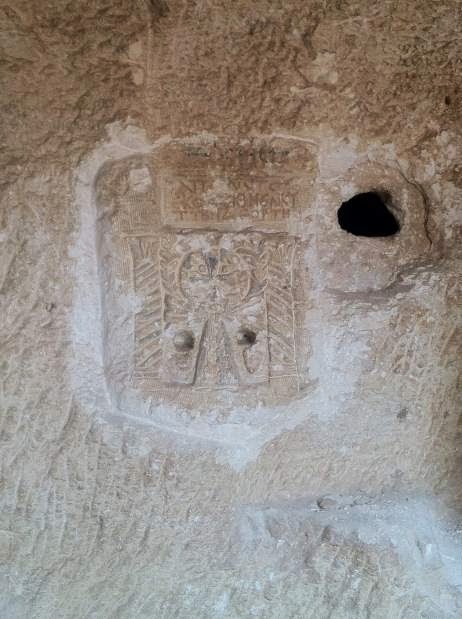
Down in the village, a four-sided stone tablet declares in English, Arabic, Coptic and hieroglyphics that the Holy Family stopped here while fleeing from Judea. On the mountain, 6th century icons painted on the church walls portray the birth of Jesus Christ and King Herod killing the children of Bethlehem; writing in five ancient tongues — Arabic, Coptic, Demotic, Greek and Syriac, a dialect of Aramaic, the language of Christ — covers the walls.
Samah Shehata, who is supervising construction of the Virgin Nunnery at the mountain's base, says Christians come here to pray every 15 days. He calls it “a beautiful thing.”
Lush farm fields circle the stark desert mountain like a green carpet; the only sound comes from an irrigation pump drawing water from the Nile.

Ancient Egyptians buried their dead in limestone mountain tombs here in Minya province. Ishaq El Bagoushy, 34, a lawyer researching the area's history, says the mountains “were holy places for … the poor and the nobles.”
This is where Christianity mixed with ancient Egypt, he says. Early Coptic Christians came here to pray and “to escape repression and preserve religious texts.”
Christian scribes lived in a cave that became a library, he explains. An escape hatch between its two floors allowed them to flee if attacked; hooks for oil lamps hang from its ceiling.

Monks of that era copied religious texts and carved hermit-like fortifications into the rock to protect them, adds Monica Hanna, an Egyptian archaeologist who works tirelessly to preserve Egyptian antiquities.
Now, like so many ancient Christian and Pharaonic sites in Egypt, this one faces a new threat.
Ansana, as this largely unstudied region once was called, is important because it documents centuries of “Christianity in Egypt, as well as the daily life of Egyptians and monks,” Hanna says.

The Coptic Orthodox church appeared here in the first century. Today, Copts are 10 percent of Egypt's population of more than 80 million — the Middle East's largest Christian concentration.
They are targets of growing violence, especially since the country's 2011 revolution. Islamists burned nearly 50 churches in August in the aftermath of the ouster of Islamist president Mohamed Morsy.
Looters are the threat to this mountain church and surrounding caves; they scavenge for artifacts to sell to tourists or collectors.

El Bagoushy points to where looters dug into one cave's floor in September. “Here they used dynamite to blow up part of the wall,” he says, gesturing toward a gaping hole. “They think there will be gold inside.”
Scavengers chipped away at an elaborate cross engraved into the rock entrance of another cave, trying to loosen it.
A similar cross, decorated with church bells and eagles, marks a cave where students once studied to become monks. Not far off, three looters brazenly dig, fresh red earth piled around the hole.

“What are you doing here?” El Bagoushy asks one of them. “I am watching. What are you doing here?” the man replies, slipping a handgun into a pocket of his dirty, ankle-length gown.
El Bagoushy says he is a guide and, surprisingly, persuades the looter to pose with him for a photograph. The other men, one carrying a shotgun, quickly scoot away.
El Bagoushy says government and church authorities ignore “all this sneak digging.”

Shehata, the building supervisor, says “teams of robbers … come here all the time.”
“We try as much as we can to stop them,” he says, “but, as you can see, they are armed.”
The mesh is ripped from a gate guarding St. Kolta Church; Shehata says authorities have ignored requests for two years to put gates on other caves.
Hanna, the archaeologist, mourns the “huge loss for Christian history” from the thievery.

This site once attracted monks from Syria and Ethiopia as well as Egypt, she says, and it all “will be gone due to the excessive looting and dynamiting … if the Egyptian government does not take steps to protect it.”
El Bagoushy agrees: “It is not just Christian history, it is Egyptian history. Any trespass on our antiquities or our history is an assault on us all.”
In the distance, a group of men ride motorcycles up the mountainside. “Look, you can see them going back up again, to continue looting,” he says.
Author: Betsy Hiel | Source: Tribune Live [December 24, 2013]